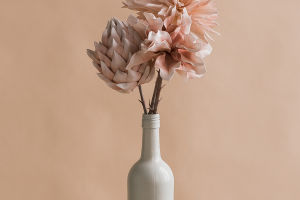A chance encounter with a beautiful butterfly is always a pleasant experience, and the sight of a butterfly dancing in the air suddenly makes all those worries about mundane matters disappear.
Beautiful butterflies are a sight to behold, and the butterfly we are talking about here is definitely one of the rarest of butterflies. Not only is it very precious, but it is so beautiful that if there were a beauty contest for butterflies, it would win the title of 'Miss Most Beautiful Butterfly'. It is the Great Blue Flicker - a master of colour with fantastic butterfly wings.
The Great Blue Flicker means beautiful and aesthetically pleasing. The blue wings are gorgeous and about 15cm long. The upper surface of the wings of the adult female butterfly is blue, and the colour and texture of the lower surface of the wings closely resembles that of a dead leaf, showing mottled brown, grey, black or red. The hairs of the larvae can cause discomfort to human skin.
The Greater Blue Flicker Butterfly lives in Central and South America and is a tropical butterfly and the national butterfly of Brazil. It is the largest species in the genus Nymphalidae, a genus of flicker butterflies, due to their colourful and very large wings. Their carapace is only about 4cm, but their wings are 15cm long, the length of an adult's hand.
In addition to their large size, their amazing wings pick up light and subtly reflect a variety of colours as their environment changes: ultramarine, dark blue, sky blue, tile blue, light blue,peacock blue, ice blue, sea blue, ghost blue ......
Many shimmering butterflies have a dazzling metallic colour. This metallic colouration acts as a protection for the butterfly. The reverse side of their wings are often greyish-brown with a number of eye spots, which effectively helps them to hide in the rainforest when resting, while when flying, the metallic colouring on the front of their wings is exposed and shines brightly in the sunlight, effectively disturbing predators. All the blues you can and can't think of can be conjured up on those dreamy, large butterfly wings.
In addition to blue, the butterfly wings transform into a magical rainbow of colourful shades of green, purple and other brilliant metallic shades, as long as the conditions are right. This is due to the special scales on the wings of the Great Blue Flicker butterfly. Under microscopic conditions, these thin, transparent scales are arranged in layers like roof tiles, pressing against each other at the edges to form a three-dimensional structure that is several times more complex than a shutter.
The front is a brilliant blue, while the back is a dull brownish-grey colour like a dead leaf. At night, when the great blue flickers are sleeping, they will rest on dead leaves in the forest, propping themselves up on their legs and closing their wings to blend in with their surroundings. At this point, even the best tracker butterfly hunters can't easily spot them.
Unfortunately, the life cycle of the adult butterfly is very short, lasting only a month. As with the life of the Great Blue Flicker butterfly, the best always comes at the end. And in the blink of an eye, this world-stunning beauty fades and passes away like a flower, never to be seen again.
Why, we ask, are beautiful things always so fleeting, like shooting stars or cherry blossoms?
Despite this, the beauty of the Great Blue Lightning Butterfly continues to fascinate the world. I thought the process was more important than the outcome. The tireless efforts of the ugly larvae bring it back to life in the end. When ugliness is transformed into stunning beauty, all the previous efforts become worthwhile.


